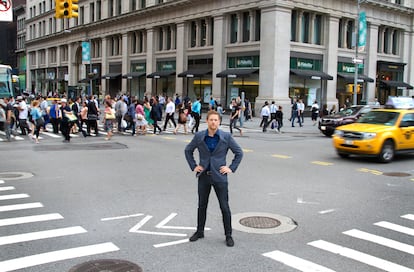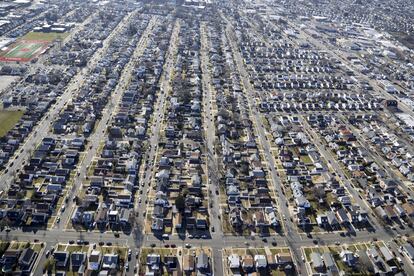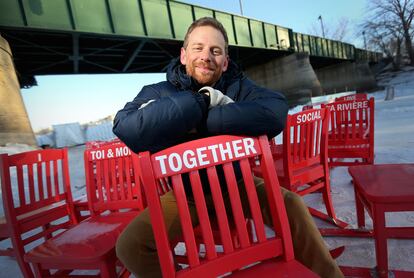Charles Montgomery, urbanist: ‘The best thing against climate change is to live close together, to share walls’
The Canadian author of ‘Happy City’ states that compact cities make us more tolerant, while dispersed ones radicalize us and cause problems for children


Decades of Hollywood films have embedded into our collective imaginations the idea that the highest social aspiration one can have is to live in a house with a garden in the suburbs. However, monsters lurk behind that idyllic image: in the 1950s, the US began an experiment in social segregation with housing for white people on the outskirts of the cities, and today that population has become increasingly alienated and radicalized. “The sprawling cities of North America are wastelands of ugliness, social disconnection and boredom,” declares Charles Montgomery, founder of Happy Cities, an interdisciplinary team that employs design to promote happier communities. The Canadian urbanist, writer and geographer is the author of Happy City: Transforming Our Lives Through Urban Design, an essay that states that compact cities (urban centers) make us more tolerant, while dispersed cities (the distant houses of suburbia) radicalize us and create problems for children in the long run.
Question. Where does this interest in cities come from?
Answer. I grew up on a farm, and when I moved to the city, I realized that I was always angry. It led me to wonder, how could city life be easier? And then I met the ex-mayor of Bogota, Colombia. His name was Enrique Peñalosa. He had redesigned his city in order to maximize happiness. Then I realized that, yes, there are some ways you can change the design of your city, and if you do, you change human behavior, you change human feelings, you can change the residents’ happiness.
Q. How?
A. Our cities influence the way we move. They influence the way we feel, the way we treat other people. They do it through the way they use public space, the way they give people access to nature (or not). In addition, there are invisible systems that matter just as much; I’m talking about things like housing affordability. Walkable streets, superblocks and bike lanes are good, but unfortunately, so many of these wonderful things are now only available to the most privileged of society. The happiest design cities have become some of the unhappiest places in the world because working people have been driven out of these places by gentrification. They are becoming luxury commodities. But it’s up to you to protect your housing. It’s up to you to ban Airbnb. It’s up to you to build more social housing, to protect the housing you’ve got.
Q. How can happiness be measured?
A. This is subjective. My definition is that a happy city is one that nurtures physical health and psychological well-being in a way that’s inclusive. A simpler answer is to just consider the subjective state of happiness. The Gallup organization survey hundreds of thousands of people around the world, asking: “How happy are you, on a scale of 1 to 10?” What’s interesting is that these subjective measures have been found to correlate really well with other measures such as health, GDP, disabled equality and social trust. A more trusting society tends to be much happier because the biggest driver of human happiness is our relationships with one another.
Q. So trusting your neighbors makes you happier?
A. When we look at international surveys on happiness, the most important ingredient for happiness is social trust. Living in a place where you have friends and where you trust your neighbors has an effect, similar to falling in love or earning tens of thousands of dollars more every year. This was the core message that I wanted to impart with Happy City: that we can build places that nurture better relationships. Barcelona is a great example, with the superblocks project and the pedestrianization of so many intersections. These are machines for happiness. When we choose to build cities for people, they become engines of human health and happiness.

Q. But more and more people live isolated.
A. This isolating, destructive and antisocial trend was born in the United States. And we know that the United States is now bearing the fruits of this decades-long project of dispersal: it is a country that is incredibly polarized. Americans are strikingly lonely and isolated and suspicious of one another. One of the reasons is that Americans no longer encounter each other on their streets. They simply do not see each other, other than through the window of their car. In cities like Barcelona, like Madrid, regular people can no longer afford the high status center, so the periphery is the answer for them. The answer is to build suburbs that are walkable, mixed use, dense enough so that nobody needs a car to get around.
Q. Does living in a big single-family home make you happier?
A. Status matters. Humans are constantly comparing themselves to each other. Consider the so-called suburban dream; the car dominated suburbia originated in the United States. In the United States, children who grow up in auto-dominated communities on the fringe, they are likely to die 3 to 5 years younger than the children who grow up in walkable, connected, dense places, mostly because they don’t learn to walk. So why do people move to the suburbs? It often is for the children. We know now, finally, that children who grow up in auto-dominated sprawls, who have parents who drive long distances, they’re more likely to use drugs and alcohol and have mental problems, because they don’t see their parents.
Q. How much influence does racism have on wanting to live in isolation?
A. In North America, the suburbs were created as a project of segregation, as well as the system we have called land zoning, which determines what you can do and how you can build on that land. When it became illegal to ban black people from neighborhoods, instead, the city planners turned to land zoning and made rules that made apartments and small homes illegal. This was a de facto way of keeping black people out of our neighborhoods. That system was built as a racist, exclusionary system. I can tell you about the effects of that decision: the voters who were most likely to switch to Donald Trump in the 2016 election were white voters who were living in disconnected, automobile dependent neighborhoods. They were people who had zero experience of the other; they were scared of them. We build systems that disconnect us from one another, and the system itself generates or sustains fear of the other. It’s a really dangerous time we’re living in now, where our online systems are polarizing us.
Q. What does it entail?
A. Wealthy people, people of privilege, have always used distance itself as a kind of wall of protection. But what we’re learning now is that simply living in isolation from the other deepens the fear of the other. We can also see this more positively: there’s a relationship between walkability and racial harmony. Researchers at MIT have found that where there are more intersections and people from different ethnic backgrounds are more likely to see each other at close proximity, those are exactly the places where people are beginning to express less hatred, dislike and aversion of other ethnic groups. There’s the magic of human contact, which is a tool for societal happiness because it reduces fear.

Q. What solution did you find?
A. After writing Happy City and gathering the evidence of the power of nature and the power of relationships and proximity, I joined a group where we asked ourselves: could we have the benefits of suburban living along with the social benefits of urban living? And to do it within the capitalist land system, our solution actually was to build a village. But because I live in Vancouver, which is expensive, we built a six-story village: 25 households. We share a rooftop garden. We share a backyard where the children play; we share amenities like a common kitchen, a workshop, a music room, a guest room. So we’ve learned that we could have the all the amenities of a suburban home, along with the richness of a connected social community.
Q. Can you design a city for cars and for people?
A. You can either design a city that works really well for cars, or you could design a city that works really well for people. But you can’t do both at the same time. Am I saying we need to ban cars from cities? No. But for the last half century, we’ve been destroying streets and neighborhoods in order to privilege the private automobile, and we’ve been building new communities that are completely dependent on private automobiles. The good news is that when we redesign our streets to make walking, biking, public transit feel wonderful and safe and comfortable, everybody benefits. In Vancouver, whenever we propose building a bike lane, the local businesses often protest, but then a year after the bike lane is built, the local businesses are making more money and they all discover that cars don’t buy things; people do.

Q. But they sell us the car as “freedom.”
A. Freedom is an essential ingredient of human happiness. The freedom to move as we please. Unfortunately, if you build your streets in ways that only serve automobiles, you steal all other kinds of freedom. You put children in a kind of urban jail, because it’s not safe for them to move around. You steal opportunities from elderly people.
Q. Are compact cities better than dispersed ones for feeling good?
A. Yes. That’s why North Americans love to go to old Spanish city centers to feel happy. The sprawling cities of North America are wastelands of ugliness, social disconnection and boredom.
Q. How much does living in the suburbs contribute to climate change?
A. Architectural design magazines are full of photo spreads displaying the super green, low carbon villas of wealthy people. But it’s very simple: as long as your life is car dependent, then your life is not green. The best thing we could do to fight climate change and to save the world is to live close together and to share walls.
Q. Is the electric car the solution?
A. The electric car does reduce greenhouse gas emissions in comparison to the traditional car. But will the electric car save cities from congestion? The purpose of electric cars is to save the automobile industry. If we give a damn about creating easier commutes for everyone, then we need to privilege the forms of mobility that are more efficient: walking, biking and public transit.
Sign up for our weekly newsletter to get more English-language news coverage from EL PAÍS USA Edition
Tu suscripción se está usando en otro dispositivo
¿Quieres añadir otro usuario a tu suscripción?
Si continúas leyendo en este dispositivo, no se podrá leer en el otro.
FlechaTu suscripción se está usando en otro dispositivo y solo puedes acceder a EL PAÍS desde un dispositivo a la vez.
Si quieres compartir tu cuenta, cambia tu suscripción a la modalidad Premium, así podrás añadir otro usuario. Cada uno accederá con su propia cuenta de email, lo que os permitirá personalizar vuestra experiencia en EL PAÍS.
¿Tienes una suscripción de empresa? Accede aquí para contratar más cuentas.
En el caso de no saber quién está usando tu cuenta, te recomendamos cambiar tu contraseña aquí.
Si decides continuar compartiendo tu cuenta, este mensaje se mostrará en tu dispositivo y en el de la otra persona que está usando tu cuenta de forma indefinida, afectando a tu experiencia de lectura. Puedes consultar aquí los términos y condiciones de la suscripción digital.
More information
Últimas noticias
Most viewed
- Sinaloa Cartel war is taking its toll on Los Chapitos
- Oona Chaplin: ‘I told James Cameron that I was living in a treehouse and starting a permaculture project with a friend’
- Reinhard Genzel, Nobel laureate in physics: ‘One-minute videos will never give you the truth’
- Why the price of coffee has skyrocketed: from Brazilian plantations to specialty coffee houses
- Silver prices are going crazy: This is what’s fueling the rally










































